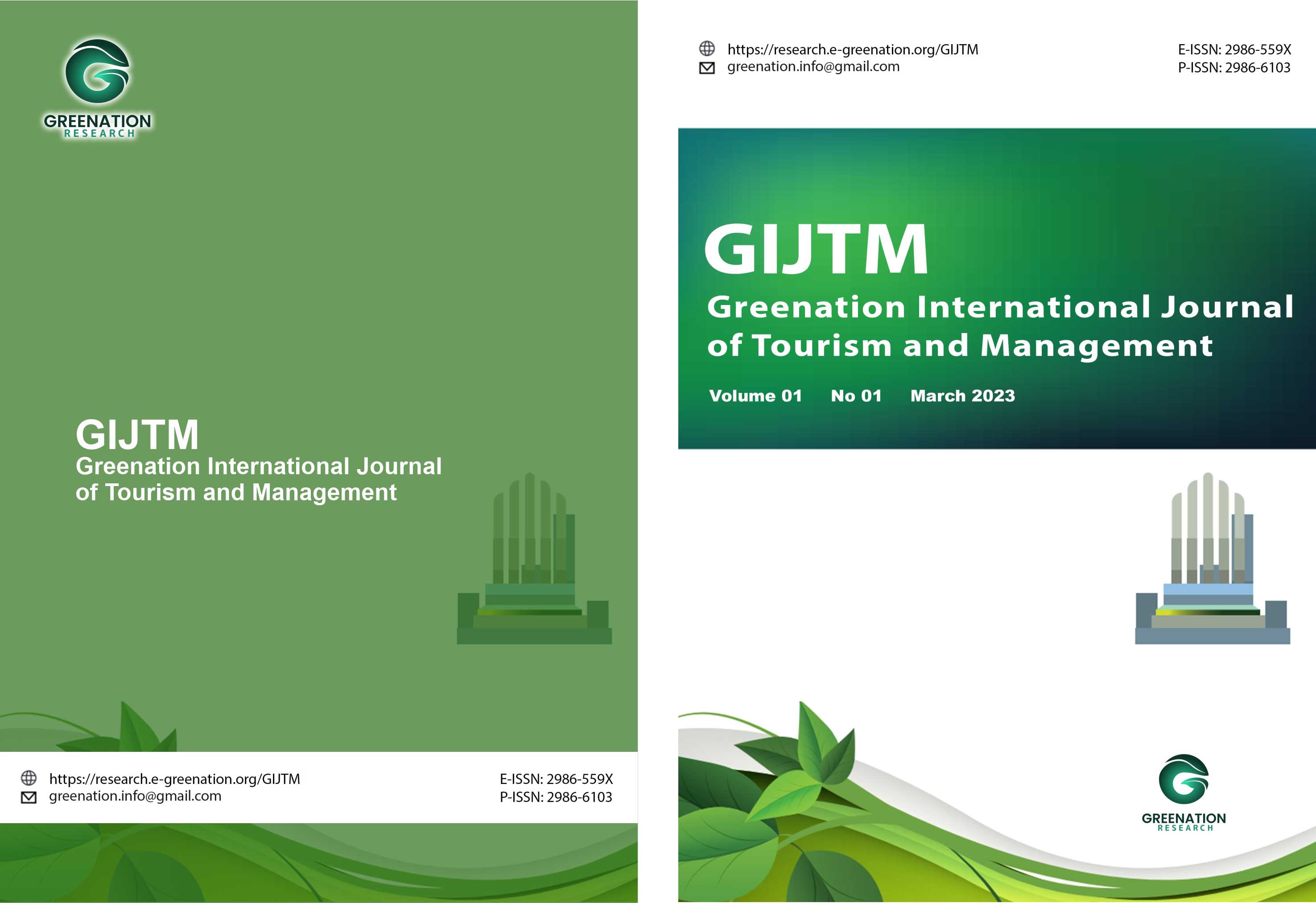The Development Strategy of Religious Tourism Area At Baiturrahman Mosque, Kampung Cibogo, Sukabumi Regency
DOI:
https://doi.org/10.38035/gijtm.v1i2.41Keywords:
Religious Tourism, Development Strategy, SOAR, QPSMAbstract
Indonesia has various tourism potentials ranging from natural tourism, religious tourism, culinary tourism, marine tourism and so on. Sukabumi Regency has religious tourism opportunities, namely the Baiturahman Mosque in the village of Cibogo. The Baiturahman Mosque has an interesting shape and architecture and has a visualized philosophy in its design. In addition, its position is also located on a hill in an area of 20 ha, equipped with a lake and vegetable plantations, but not yet developed. The purpose of this study was to map and select a strategy for developing religious tourism in the Baiturahman Cibogo Sukabumi Mosque area using the SOAR and QSPM methods. This research is expected to identify priority strategies to improve the quality and attractiveness of religious tourism areas as well as to have a positive impact on the environment and society. The research method uses SOAR (Strength, Opportunity, Aspirations, Result) and QSPM (Quantitative Strategic Planning Matrix) analysis to determine strategic priorities in realizing the development of the Baiturrahman Mosque religious tourism area. The results of the QSPM analysis led to carrying out a branding strategy for the religious tourism area of the Baiturahman Mosque by utilizing information technology, especially digital marketing, in the form of social media, content, websites and so on. In addition to strengthening branding, it is carried out in the form of maximum service to achieve visitor satisfaction and increase promotional and branding value. For this reason, collaboration with various parties is also needed, which will add to this branding strategy, professional travel, and tour partnerships, as well as elements of the mass media and government elements that support the development of religious tourism at the Baiturahman Mosque, Cibogo-Sukabumi can be guaranteed with the highest score of 2.5128.
References
Damanik, Phil, Janianto. 2013. Indonesia Tourism Between Opportunities and Challanges. Yogyakarta: Pustaka Pelajar.
Dminik, Janiant, dkk. Eco-tourism Planning from Theory to Application. Yogyakarta: 2006.
David, Fred R. 2011. Strategic Management. Jakarta: Publisher Salemba Empat.
Dr. Ismael Nurdin, Dra. Sri Hartati, M. S. (2019). Social Research Methodology.
Fadli, M. R., Siroj, M. Z., & Lukmandono. (2021). Understanding the design of qualitative research methods. Humanika, 21(1), 170–175. https://doi.org/10.21831/hum.v21i1.38075
Dwi Anggrayana Nurzanah , Erry Rimawan, M. K. (2015). Facing Cosmetic Product Competition Using the Swot Method, Ie Dan Quantitative Strategic Planning Matrix (QSPM). Integrasi Sistem Industri Journal, 2(2), 29–38. https://jurnal.umj.ac.id/index.php/jisi/article/view/1852/1507
Dzakwan, A. O., & Budiman, R. (2020). Marketing Strategy to Increase the Number of Visitors to the MSME Center in Pontianak City Using the SWOT and QSPM Methods. TIN Universitas Tanjungpura, 4(2), 214–223.
Fauzi, Muchamad. 2015. Strategic Management. Semarang: CV Karya Abadi Jaya.
Freddy Rangkuti, 2004, SWOT Analysis Techniques for Dissecting Business Cases, PT. Gramedia, Jakarta
Hasibuan, S., & Amela, F. (2019). Implementation of Quantitative Strategic Planning Matrix (Qspm) in Planning Marketing Strategy for Happy Bubble Drink Business in Binjai City. Journal of Business Administration (BIS-A), 08(c), 26–36.
Henee, Aime, dkk. 2010. Public Organization Strategy Management. Bandung: Rafika Aditama.
Husein. 2010. Strategic Management Research Design. Jakarta: PT Grafindo Persada.
Hurul, Aini. 2015. Hapanasan Featured Tourism Object Development Strategy by the Rokan Hulu Culture and Tourism Office. Ilmu Admisnistrasi Publik. University of Riau
I Gusti Bagus Rai, dkk. 2012. Tourism and Hospitality Research Methodology. Yogyakarta: CV Andi Offset.
Marpaung, Happy. 2002. Introduction to Tourism. Bandung: Alfabeta.
Moch Mahsun, Muslim Friendly Tourism Creative Industry Development Strategy Through SOAR Analysis and Quantitative Strategic Planning Matrix (QSPM) OECONOMICUS Journal of Economics, Vol. 6, No. 2, June 2022
Mustika, ahsana. 2011. Management of religious tourism (study of masjid agung semarang). Pendidikan Agama Islam University of Semarang
Pendit, Nyoman S. 2006. Tourism Science: An Introductory Prime. Jakarta: PT. Pradnya
Paramita.
Ridwan, Muhamad. 2012. Tourism Development Planning. Medan: PT. Sofmedia.
Soebagyo. 2012. “Tourism Development Strategy in Indonesia”. Liquidity Journal Vol.1 No. 2.
Yoeti, Oka A. 1996. Integrated Tourism Marketing. Bandung: Angkasa.
Santoso, D., & Widyatmini, T. (2021). Creative Economy Development Strategy Through Soar Analysis (Case Study: Clothing Solid Object Business). Ug Jurnal, 16(4), 58–66
Sugiyono. 2013. Educational Research Methods Qualitative Approach, Quantitative, R&D. Bandung: Alfabeta.
Suwantoro, Gamal. 1997. The Basics of Tourism . Yogyakarta: Andi Offset. Utama,
Sunaryo, Bambang. 2013. Tourism Destination Development Policy Concepts and Applications in Indonesia. Yogyakarta: Publisher Gava Media.
Suwantoro, Gamal I. 2004. The Basics of Tourism. Yogyakarta: CV Andi.
Rayanto 1998. Strategic Management In Action. Jakarta: Gramedia Pustaka Utama.
Yoeti, Oka. A. 2008. Tourism Planning and Development. Jakarta: Pradnya Paramita.
Downloads
Published
How to Cite
Issue
Section
License
Copyright :
Authors who publish their manuscripts in this journal agree to the following conditions:
- Copyright in each article belongs to the author.
- The author acknowledges that the Greenation International Journal of Tourism and Management (GIJTM) has the right to be the first to publish under a Creative Commons Attribution 4.0 International license (Attribution 4.0 International CC BY 4.0).
- Authors can submit articles separately, arrange the non-exclusive distribution of manuscripts that have been published in this journal to other versions (for example, sent to the author's institutional repository, publication in a book, etc.), by acknowledging that the manuscript has been published for the first time at GIJTM.


























